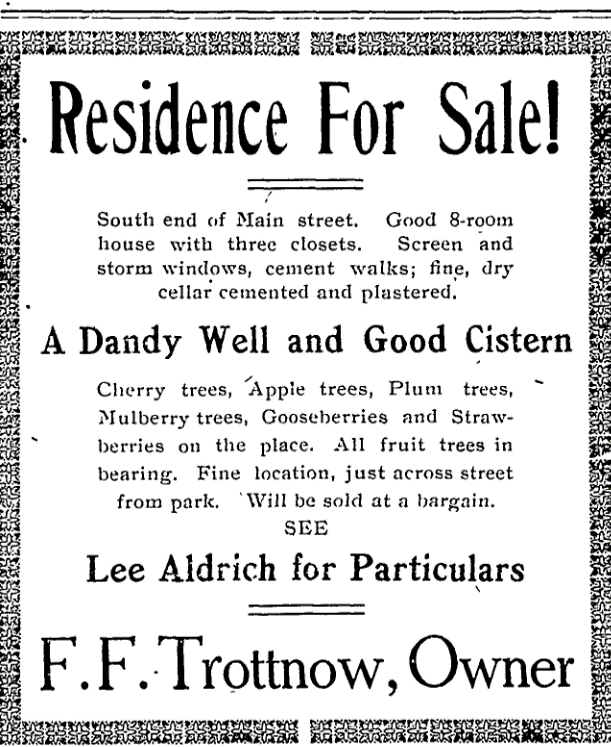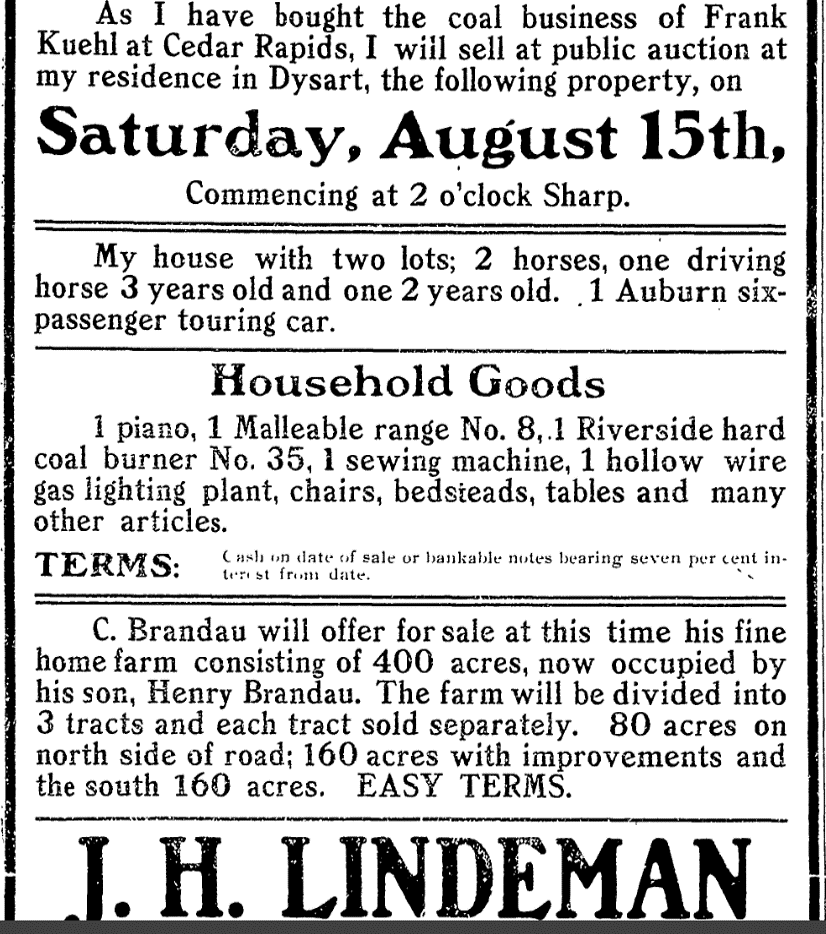“Thieves Keep Auto But Return Trunk, Bag and Clothing”
Please note: This is a true story. The names of the people have been changed. The details have not.
On an early December night in 1923 a man from one of the small towns reported to Waterloo, Iowa, police that his car had been stolen. He had parked his vehicle in front of the Scobby residence at 217 Second Street West (now the site of the Dan Gable Wrestling Museum). No details are known about why this man was visiting that location. Newspaper reports show that car theft was occuring fairly regularly in Waterloo that year. At the time, he was a 29 year old, married farmer. It appears this was the home of a respectable family who may have also had some boarding rooms. The (Waterloo) Evening Courier and Reporter reported that this man, Martin, had his new Ford Coupe with license number 12-5778 stolen. He further reported the stealing of a trunk and suitcase which were in the car. About one week later, a large package and the suitcase were mysteriously delivered by express to Martin’s home in the Dysart area. His address was plainly and correctly written. The place of mailing was St. Paul, Minnesota. According to the paper, the name and address of the sender were on the package but were believed to be fictitious. Practically all of the stolen clothing, which consisted mainly of new and valuable women’s apparel was in the returned packages. No trace of the automobile was found. Police theorized that the thieves drove the auto to St. Paul and “finding the contents were of character dangerous to attempt to dispose of, determined to send them to the owners in a way which would cause the least liability of discovery.”
How curious! Why would thieves who had stolen a valuable automobile trouble themselves over some far less valuable clothing? Surely being traced back to a stolen vehicle would have been more significant than being found with a bunch of clothes. Why risk going to a station and having these items shipped? Minnesota is known as the Land of Lakes, surely they could have found a river or lake along the to throw the trunk and suitcase in. Were there no lonesome places where they could have buried the loot? Why would the thieves spend their money returning these insignificant items to someone from whom they were inclined to steal?
Perhaps knowing more about the victim can shed light on these questions. Martin came from a prominent family in the Mooreville area, a settlement located between Waterloo and Dysart, Iowa. His grandfather was one of the first white settlers in Geneseo Township . County records of this wealthy and influential family in date back before the 1860s. The local papers of the time chronicle his parent’s business ventures including purchasing land close to home but also in the Dakotas and California. He had married Alfreda, the daughter of another prominent family, and taken up farming in 1914. Between 1914 and 1922 newspaper reports show that he was doing what other new husbands and fathers do. He was renting land from his father, selling timothy grass, purchasing hogs, and shipping hogs to the Chicago markets. The couple do appear to have done quite a bit of traveling in those years. From the social columns it is unclear if these were unsuccessful moves out of area or just long visits in the Dakotas and California.
In 1911, Martin’s father, Carlton, decided to sell his farm and move to California for the winter along with his wife, Lacy. Martin was just 17 or 18 at the time Carlton was quoted in the paper as saying that his children “would have to find a way to look after themselves”. In December of that same year Martin’s sister, Elsie, got married and moved with her husband to a new community. In language that would never be used today, the Traer Star Clipper reported “The young folks were intending to be married in the spring, but matters were somewhat hurried by the bride’s parents who intend to spend the winter in California.” By this time, Carlton had already sold the farm. The paper continued “So this daughter took the first chance that came along and found a splendid young fellow to take care of her.”
In 1920, the father died and left his estate to his wife who by then was back in Dysart. She died four years later in 1924. Her will which had been drawn up in 1918 revealed an estate worth $50,000. The conditions of the will were a bit strange and may provide a clue about Martin. Money was set aside for her grandchildren and after that was divided into four equal parts. Three of her children received their full share immediately. However, the last 1/4 share was to be divided between Martin and his brother, John. Additionally, that share was to be held in trust by the Dysart State Bank and the brothers received the interest only. Upon their deaths, the money immediately passed to Martin and John’s children. Starting almost immediately both Martin and John along with the bank were sued by creditors for money from that inheritance to pay for outstanding debts. These court cases drug on and on for so long that in 1938 the bank tried to remove themselves from management of the funds. Another person was appointed by the courts and that person turned the responsibility down.
The early 1920’s appear to have been a challenging time for Martin. In 1919 it was noted in the paper that he had lost a cow and a good horse. How this happened was not clarified. In May of 1922 he was caught up in a prohibition sweep by the Tama County Sheriff. Arrested with a gallon of alcohol in his car which was parked outside the Dysart Opera House during a dance, hee pled guilty to possession and transportation of alcohol and was fined $137.00. In February of 1923, he was arrested by the Waterloo police on a traffic violation of cutting corners. Within the same week of having his car stolen in Waterloo, his brother, John, was caught up in a gambling sweep in Dysart and was also arrested. The rest of his life story is not entirely clear. It is obvious that he and Alfreda divorced. In May of 1929 she married another Tama County resident and moved to Greeley, Colorado, where she lived out the rest of her days. By 1950 Martin was living in Brooklyn, New York with a wife. By 1960 he was in Florida. It appears he died in Florida in 1970 at the age of about 76 years old. How he made his living after leaving Iowa is unknown.
So Reader, what do you think?
Does it make sense to you that the random strangers who stole his car returned his items via Express or do you have another theory?
What other information do you need to know in order to make up your mind?
Please post your thoughts to the Facebook page where you are reading this or send me an email. I’d love to hear your thoughts.





































 The colors of 1914
The colors of 1914  Two paint colors regularly advertised as available during 1914 were Paris Green and Venetian Red Ground, both very familiar colors. Venetian red was a popular choice for barns and farm buildings. The paint got it's name because historically this pigment was produced from natural clays found near Venice, Italy. The clays contained an iron oxide compound that produced this red color. By the 1920s, these clays were being mined throughout the US including in Iowa making the paint readily available and affordable. . The paint was non-toxic.
Two paint colors regularly advertised as available during 1914 were Paris Green and Venetian Red Ground, both very familiar colors. Venetian red was a popular choice for barns and farm buildings. The paint got it's name because historically this pigment was produced from natural clays found near Venice, Italy. The clays contained an iron oxide compound that produced this red color. By the 1920s, these clays were being mined throughout the US including in Iowa making the paint readily available and affordable. . The paint was non-toxic. was used as both an insecticide and paint pigment. Because of it's make-up the substance was highly toxic and required care in handling. That summer in Iowa, a farm wife living northeast of Clutier was found dead in her home. Her death was ruled a suicide as the result of taking a dose of Paris green. She was not alone. Over the counter poisons were often the chosen method of suicide in the early 1900s.
was used as both an insecticide and paint pigment. Because of it's make-up the substance was highly toxic and required care in handling. That summer in Iowa, a farm wife living northeast of Clutier was found dead in her home. Her death was ruled a suicide as the result of taking a dose of Paris green. She was not alone. Over the counter poisons were often the chosen method of suicide in the early 1900s.












